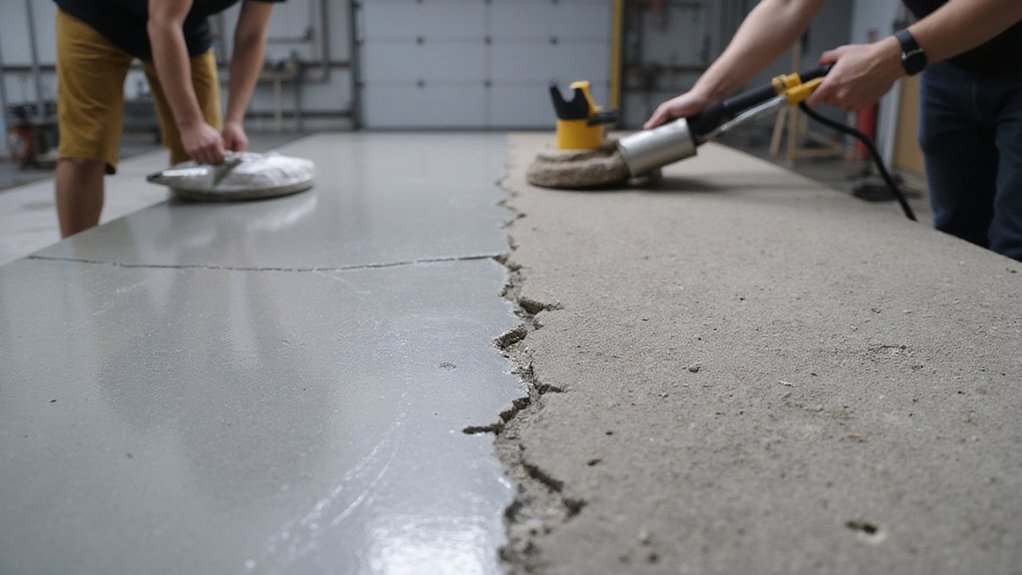When sealing concrete, you’ll want to choose the right sealer for your project and prep your surface diligently. Clean thoroughly, repair any damage, and guarantee the area’s completely dry before applying. Use thin, even coats with quality tools, and avoid rushing the process. Don’t skip surface cleaning or use the wrong sealer type. Stick around, and you’ll discover the secrets to a professional-grade concrete seal that’ll make your DIY project shine.
Understanding Concrete Sealer Types

There are three primary types of concrete sealers that DIY enthusiasts should know about: penetrating, topical, and integral sealers.
Penetrating sealers plunge deep into concrete, creating invisible protection. You’ll love topical sealers like epoxy based sealers and acrylic based sealers, which form a protective layer on the surface. They’re great for enhancing color and providing a glossy finish. Acrylic sealers specifically can darken or lighten concrete color depending on the product used.
Integral sealers mix directly into concrete during mixing, offering waterproofing from the inside out. Each type has unique advantages, so choose based on your project’s specific needs and the level of protection you’re after.
Surface Preparation Essentials
Selecting the right concrete sealer is just the start—now you’ll want to prepare your surface for maximum sealing effectiveness. You’ll need to command concrete cleaning methods that strip away dirt, oil, and grime.
Pressure washing requirements are critical; use a washer with at least 3000 PSI to blast away stubborn residues. Let surfaces dry completely before applying sealant.
Repair any cracks or chips first, and consider using a degreaser for heavily stained areas. Pro tip: rough surfaces absorb sealant better, so consider light sanding if your concrete feels too smooth. Concrete repair techniques suggest addressing surface imperfections before sealing to ensure optimal adhesion and longevity.
Application Techniques and Best Practices
The magic of concrete sealing lies in commanding application techniques that safeguard long-lasting protection. You’ll want to command proper brushing techniques and roller application methods to guarantee an even, smooth finish.
Start by choosing high-quality tools that won’t shed bristles or leave streaks. When using a roller, work in consistent, overlapping strokes to prevent pudding or uneven coverage. Apply thin, multiple coats rather than one thick layer, allowing adequate drying time between applications.
Watch your technique closely, maintaining a steady hand and keeping the surface clean throughout the process. Concrete finishes require precise application to ensure optimal durability and performance, minimizing the risk of cracking and wear over time.
Common Mistakes to Avoid
Everyone makes mistakes, but when it comes to concrete sealing, some errors can cost you time, money, and a pristine finish. Inadequate surface cleaning is a top blunder that’ll sabotage your project before you even start. You’ll want to avoid skimping on prep work and guarantee thorough cleaning and repair. Crystalline admixtures can provide an additional layer of protection for your concrete surface.
| Mistake | Consequence | Solution |
|---|---|---|
| Poor Cleaning | Weak Seal | Thoroughly clean surface |
| Uneven Application | Patchy Protection | Use consistent roller technique |
| Wrong Sealer | Ineffective Coverage | Match sealer to concrete type |
| Rushing Process | Compromised Finish | Follow manufacturer’s instructions |
Insufficient product coverage can leave your concrete vulnerable, so take your time and apply evenly.
Maintenance and Long-Term Care
Keeping your sealed concrete looking sharp and performing well boils down to consistent, smart maintenance. You’ll want to follow proper cleaning procedures using pH-neutral cleaners and soft-bristled tools to prevent surface damage.
Regular periodic inspections help you catch early signs of wear or potential issues before they become costly problems. Clean spills immediately, avoid harsh chemicals, and reapply sealant every few years as needed.
Frequently Asked Questions
How Long Does Concrete Sealer Typically Last Before Needing Reapplication?
You’ll want to reapply concrete sealer every 2-5 years, depending on traffic, weather exposure, and the sealant type. Your specific surface conditions will determine its longevity.
Can I Seal Concrete During Cold or Rainy Weather Conditions?
You’ll want to avoid sealing concrete in wet weather or temperatures below 50°F. Cold and damp conditions prevent proper adhesion, so wait for dry, warm days when your sealer can cure effectively.
Are Concrete Sealers Safe for Areas With Heavy Foot Traffic?
You’ll find concrete sealers designed for high-traffic areas with impressive high wear resistance and skid resistance. They’ll protect your surface while keeping it safe and looking fresh, so you can walk confidently without worry.
Will Sealing Prevent Existing Cracks or Damage in My Concrete?
Sealing won’t magically repair existing cracks, but it’ll help prevent future damage. You’ll enhance crack mitigation and protect your concrete from further deterioration, giving you peace of mind.
Do Concrete Sealers Change the Appearance of My Surface Color?
You’ll definitely see changes! Some sealers can give your concrete an improved sheen and potentially darken its pigment, altering your surface’s look from dull to strikingly different.
